How to Launch a B2B Multi-Vendor Marketplace Successfully

The term “B2B Multi-vendor Marketplace” may sound unfamiliar to most people, but I believe most of us already use one. For example, when you hail a ride with Uber, you are actually interacting with a B2B Multi-vendor Marketplace. Uber is a platform that connects many drivers with riders and takes a commission from each ride. Amazon is another example of a B2B Multi-vendor Marketplace. Amazon allows unlimited sellers to provide their products on the platform and takes a commission from each sale.
Although the term may not be familiar, we interact with this model daily without even realizing it. These platforms provide a convenient way for businesses to connect with each other, and they have become an essential part of the modern economy.
Let’s learn more about this business model and how big companies launch a booming B2B multi-seller marketplace.
Overview
Single-vendor vs. Multi-vendor marketplaces
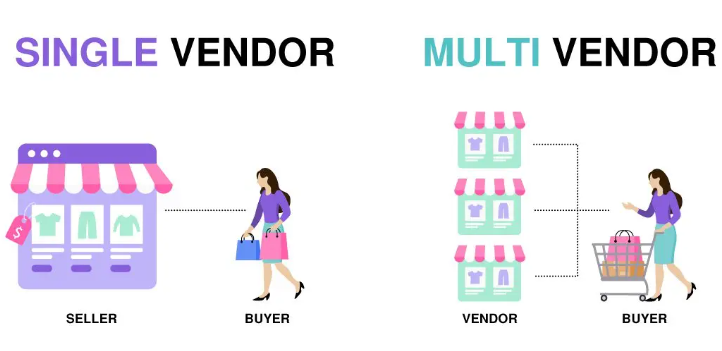
The single-vendor Ecommerce model is a marketplace where only one single seller supplies its items to many customers. Such stand-alone stores typically don’t provide a broad range of products or services.
In contrast, multi-vendor Ecommerce stores allow various sellers to gather on one marketplace and supply their goods, meaning customers can purchase from different brands on the same market. Big names like Amazon, Taobao, eBay, Etsy, AliExpress, and Flipkart are all examples of wholesale multi-vendor marketplaces.
Crucial features of B2B multivendor marketplaces
-
Admin perspective
- Complete admin control
- Platform product management
- Multiple revenue streams
- Multilingual & multi-currency
- Multiple payment methods
- Secure payment gateways
- Inventory management
- Tax management
- Streamlined shipping management
-
Seller perspective
- Request for quote module
- Bulk price discounts
- Minimum order discounts
- Partial payments offer
- Real-time inventory updates
- Separate vendor store
Why Companies Are Increasingly Leveraging B2B Multi-Vendor Marketplace Models
Running a B2B multi-vendor marketplace might be a relatively new concept, but companies embracing this model are already surpassing their less innovative counterparts. According to a report of McKinsey, over the past two years, 72% of B2B firms that adopted a marketplace have seen an expansion in their market share, compared to only 42% of those that haven’t.
There are three key reasons why operating a company-owned B2B multi-vendor marketplace is proving to be highly effective:
Expanded Product Variety and Depth
The multi-vendor marketplace approach fosters collaborative commerce, enabling B2B companies to enrich their product offerings without the need to develop new items themselves. Instead of manufacturing and storing products, marketplace operators can curate diverse selections by partnering with compatible businesses. This strategy not only reduces costs but also facilitates agile responses to evolving consumer preferences.
Enhanced Customer Reach and Website Traffic
By showcasing products from multiple vendors, the marketplace owner can attract more visitors to their platform, thus increasing exposure for their own listings. Through this symbiotic relationship with other vendors, the platform operator gains access to new customer segments while extending its reach. This dynamic creates a self-reinforcing cycle of growth, where a broader product range attracts more buyers, subsequently enticing additional sellers to join the marketplace.
Improved Customer Experience
B2B buyers are influenced by their experiences as retail consumers, with expectations shaped by platforms like Amazon. The demand for similar experiences in the B2B sphere is evident. A B2B multi-vendor marketplace provides customers with an Amazon-like shopping journey, meeting their desire for choice and personalized service through data-driven insights harnessed by the operators.
Reasons Why B2B Marketplace Will Continue to Be Trending in the Future

By 2023, the B2B ecommerce market is foreseen to reach $1.8 trillion, constituting approximately 17% of total US B2B sales. This growth trajectory is expected to continue globally, with projections indicating a more than twofold increase in online B2B sales to reach $18.57 trillion by 2026.
Several significant trends are driving interest in B2B multi-vendor marketplaces and are anticipated to further fuel B2B ecommerce in the foreseeable future:
Cost Efficiency and Transaction Expansion
Businesses across various sectors view marketplaces as an avenue to manage increased transaction volumes without a corresponding rise in operational expenses. By establishing a multi-vendor marketplace, operators can garner a share of sales from other vendors without necessitating additional physical warehouse capacity.
Influence of Key Players
The dominance of major players like Amazon Business, Alibaba, Faire, and automated distributors such as Grainger is prompting other market participants to explore new models and foster innovation within the B2B ecommerce landscape.
Cost Sharing and Enhanced Visibility
Smaller enterprises stand to benefit from cost-sharing arrangements when they join multi-vendor marketplaces. By participating in a network, they can distribute advertising expenses among multiple vendors, thereby amplifying the visibility of their products and optimizing the value derived from advertising investments.
Shifting Dynamics for Manufacturers
Manufacturers are increasingly inclined to diverge from the traditional wholesale model to exert greater control over their brands, inventory, and customer data. Operating a B2B multi-vendor marketplace enables manufacturers to retain ownership of these elements while facilitating direct engagement with customers, thus aligning with evolving market preferences and objectives.
Main Benefits of B2B Multi-Vendor Marketplaces
Running a multi-vendor marketplace might be something new in B2B, but for businesses that applied this model, things have already been better than those still considering whether to join.
Why? Let’s find out the benefits of having a B2B multi-vendor marketplace:
1. Expand Product Options
The multi-vendor marketplace model in B2B involves collaboration and curation. Rather than creating new products, companies can showcase products from various other vendors that complement their own offerings. This approach diversifies their product range without the need for extensive manufacturing.
By partnering with like-minded businesses, marketplace operators can swiftly adapt to changing customer demands. This agility enhances their competitiveness and relevance. The multi-vendor marketplace is a flexible and cost-effective strategy that allows B2B companies to expand their offerings while fostering valuable partnerships in their industry.
2. Raise Web Traffic and Increased Customer Reach

By offering items from various vendors, the marketplace owner can draw more attention to their own product offerings as shoppers review the site. It’s a win-win situation. Since the platform administrator shares their buyer’s network, they also gain access to other vendor’s distinct customer base.
This interdependent mechanism, known as the flywheel effect, explains how this symbiotic relationship between multiple vendors fuels continuous expansion. In essence, a marketplace with a broader product spectrum captures the interest of a larger pool of potential buyers, subsequently encouraging more sellers to join the platform. This flood of new vendors then attracts additional customers, perpetuating the cycle of growth.
3. Improve Customer Experience
Remember that B2B buyers are still retail consumers. Their shopping habits outside of work influence their expectations for company purchases. The growth of Amazon inevitably raised demand for B2B analogs.
Customers get an Amazon-like experience with a B2B multi-vendor marketplace system, which is exactly what most business buyers desire. By exploiting user data, operators may provide consumers with more options as well as a personalized experience.
4. Lower Financial Burden
Not only saving costs for making new products like mentioned above, the multi-vendor marketplace can help sellers save money and grow their business in other aspects. Sellers do not need to invest in a warehouse or hire staff to manage inventory. This can free up the seller’s time and resources to focus on other business objectives, such as scaling up their operations efficiently. Additionally, a multi-vendor marketplace can give sellers access to a broader audience of potential customers than they would have.
5. Efficient Logistics

In a B2B marketplace, vendors are responsible for the quality of their goods, while the market is responsible for the logistics of delivering those goods. This mission includes finding the best shipping partners, negotiating the best rates, and tracking shipments to ensure they arrive on time and in good condition.
A B2B multi-seller marketplace can improve logistics efficiency in several ways. First, it can aggregate demand from various vendors, giving the marketplace more bargaining power with shipping partners. Second, the marketplace can use data analytics to identify the most efficient shipping routes and times. Third, the marketplace can provide vendors with real-time tracking information so that they can keep track of their shipments and intervene if necessary.
By optimizing the logistics process, the B2B marketplace can free up vendors to focus on other core objectives, such as product development and marketing. This can improve the efficiency of the entire supply chain and ultimately lead to better overall performance.
How to Build a B2B Multi-vendor Marketplace
By now, the process of setting up a first-party ecommerce store is a well-established journey, with widely recognized best practices. The majority of B2C retailers typically opt for out-of-the-box solutions like Shopify, with around 90% of stores relying on single-vendor ecommerce platforms where retailers pay a subscription fee for the software. However, the landscape for B2B marketplaces presents a different challenge. B2B marketplaces are still an emerging trend, and companies are exploring various approaches to launching them. Unlike B2C ecommerce, there are fewer established models of success to follow, requiring a more experimental approach.
Overall, there are two ways to start a B2B multi-seller marketplace: building everything from the beginning or going with the existing ecommerce platforms.
1. Custom Build
Building a custom marketplace from scratch gives the operator complete control over the platform, but it is also the more expensive and time-consuming option. The development process can be complex and costly, and the platform must be constantly updated as technology evolves. This can make it challenging to validate the marketplace and ensure its success.
2. Integration with Existing Ecommerce Platforms
Businesses currently involved in online direct-to-consumer sales may be enticed to integrate B2B marketplace features into their existing ecommerce platforms. This seems appealing because ecommerce platforms effectively oversee the customer journey, handle customer service, and offer cataloging and inventory-tracking tools.
However, while ecommerce platforms excel in these aspects, they are inherently unsuitable for accommodating the complexities of a multi-vendor marketplace. Fundamentally, they are tailored to facilitate transactions solely between a single seller and a group of buyers. Unlike marketplaces, which necessitate platforms capable of managing transactions across numerous vendors simultaneously.
Top B2B Ecommerce Platforms for Multi-vendor Marketplace
Magento

Magento is an open-source multi-seller Ecommerce platform. It is designed for both small-scale and large organizations in the retail industry. Magento allows you to edit, create, and manage Ecommerce websites, offering a personalized consumer experience. The platform is easy to customize and allows seamless third-party integrations.
- Custom coupon code creation
- SEO management
- Product review promotion
- Multiple payments and shipping options
- PCI-DSS compliant
YoKart
Yo!Kart
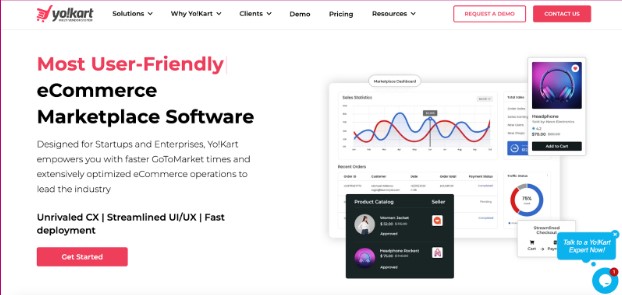
Yo!Kart presents a potent self-hosted eCommerce solution ideal for constructing a multi-vendor marketplace.
It offers businesses complete control and flexibility in establishing and managing their versatile online marketplace.
Whether you’re launching a startup or managing an established enterprise, Yo!Kart streamlines the process of creating your own online marketplace with ease and efficiency.
Vendors can create their unique storefronts and access specific user panels, including Admin, customers, affiliates, and advertisers.
Key Features:
-
Multi-vendor functionality.
-
Customizable design and themes.
-
Up to 1-year free technical support.
-
Advanced reporting and analytics.
-
Flexible payment options.
-
SEO-friendly architecture.
-
Dedicated mobile app for buyers and sellers
BigCommerce Enterprise

BigCommerce is known as a flexible and easy-to-use open SaaS-based option for those who are looking to launch Ecommerce business. The platform was founded in 2009, allowing users to customize a new B2B Ecommerce store easily. The modernized platform enables you to build trendy site designs via unique features like segmenting customers and prices. Moreover, BigCommerce can integrate with other business tools to maximize site performance.
- Customizable design themes
- Abandoned cart savers
- Pre-integrated payment options
- Professional SEO tools
Shuup

Shuup stands out as a state-of-the-art multi-vendor platform, empowering businesses to effortlessly create and manage dynamic online marketplaces.
Its modular design facilitates extensive customization, ensuring your marketplace perfectly aligns with your unique needs and objectives.
With Shuup, tasks like vendor management, order processing, and product listings become effortlessly manageable.
Its array of features, including multi-language support, SEO optimization, and robust analytics tools, position Shuup as a comprehensive solution for businesses seeking to establish a thriving online presence.
Key Features:
-
Multiple vendor support for seamless onboarding of numerous sellers.
-
Scalability to adapt and expand your marketplace alongside your business growth.
-
Integrated payment gateways ensure secure and smooth transactions.
-
Efficient product catalog management streamlines organization and display of products.
-
Comprehensive reporting offers valuable insights into your marketplace’s performance.
CS-Cart
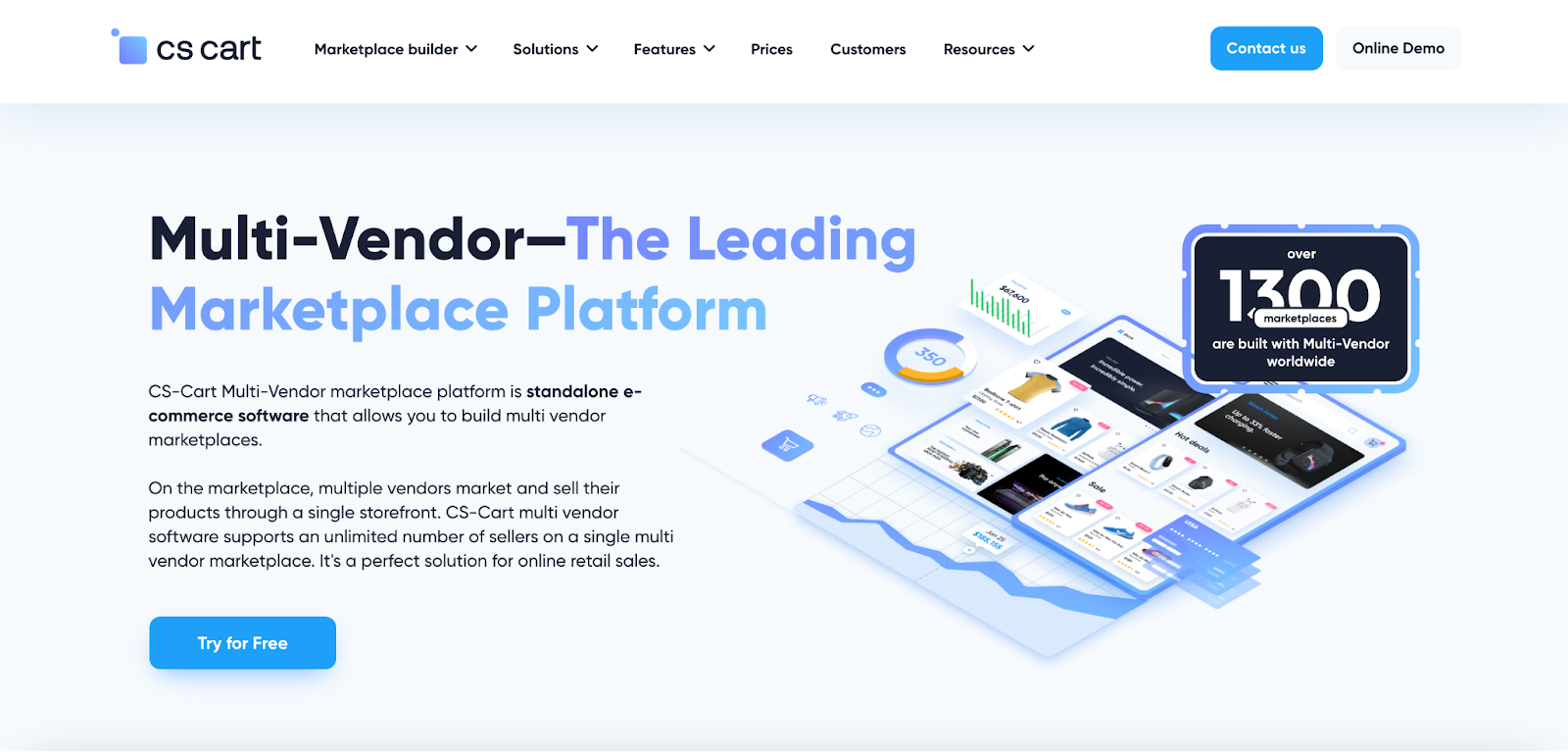
CS-Cart Multi-Vendor stands as a robust e-commerce platform empowering businesses to create fully customizable online marketplaces.
With support for 26 built-in languages and a plethora of features, this all-in-one solution offers remarkable flexibility, catering to diverse industries and user requirements.
Noteworthy aspects of CS-Cart Multi-Vendor include advanced order management, multiple payment options, and real-time shipping calculations.
Its user-friendly interface coupled with powerful features positions it as an appealing choice for businesses aiming to launch a successful multi-vendor marketplace.
Key Features:
-
Responsive design ensures seamless user experiences across all devices.
-
On-site content editing facilitates effortless updates to marketplace content.
-
Advanced search functionality with 45 parameters for precise product discovery.
-
Detailed statistics and comprehensive reporting tools aid in optimizing marketplace performance.
-
Admin access levels enable precise control over user permissions for enhanced management
PrestaShop
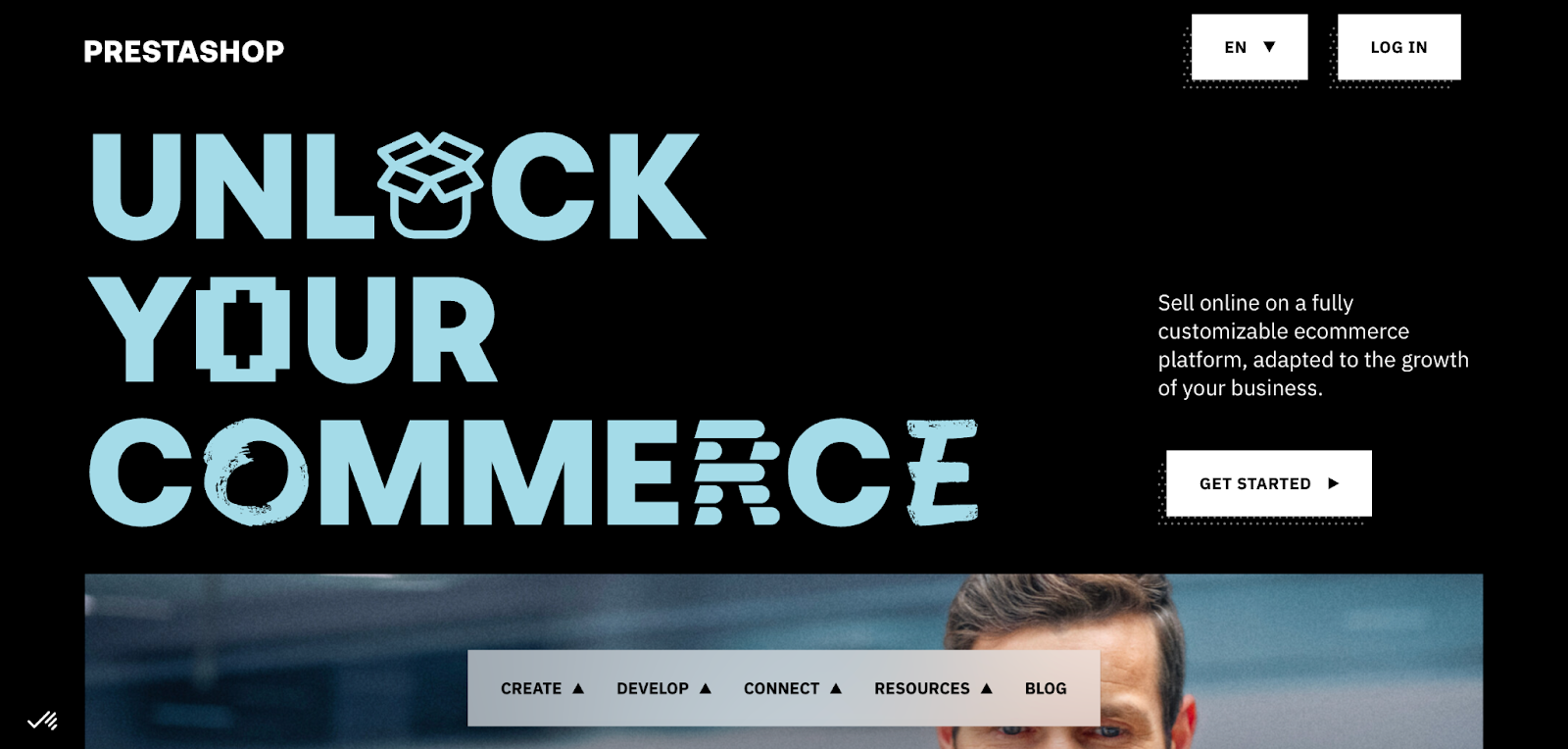
PrestaShop is a widely used open-source e-commerce platform, empowering businesses to effortlessly establish feature-rich online stores.
With an array of built-in features and a vast selection of add-ons, PrestaShop facilitates extensive customization and scalability. The platform encompasses functionalities such as inventory management, multi-language support, and integrated marketing tools. Its thriving community of developers and extensive documentation contribute to its appeal, offering businesses a well-supported and flexible marketplace solution.
Key Features:
-
Open-source platform providing flexibility and customization options.
-
Built-in features offering comprehensive functionality out of the box.
-
Access to over 5,000 add-ons to enhance your online store’s capabilities.
-
SEO-friendly architecture with multilingual and multi-currency support, enabling expansion into global markets.
X-Cartg
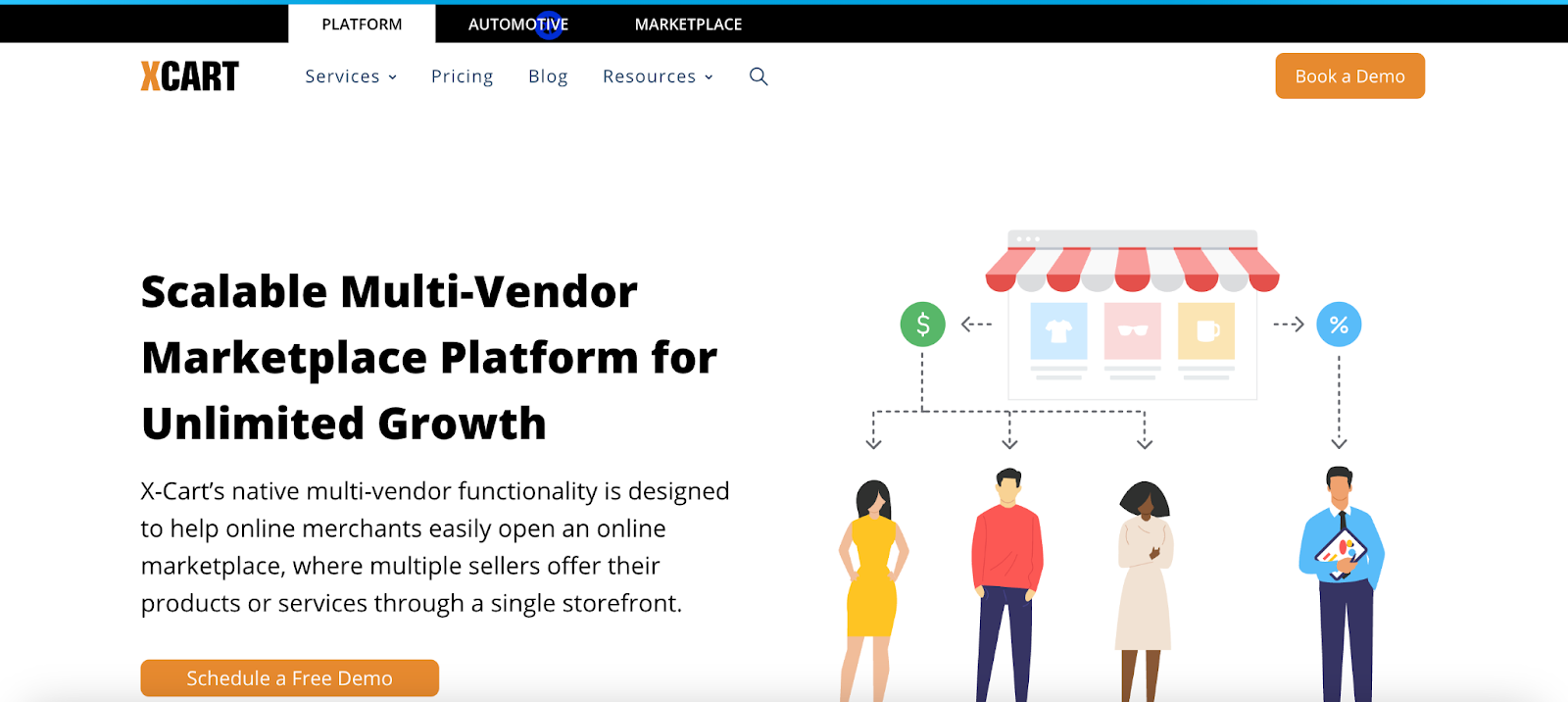
X-Cart Marketplace stands as a robust e-commerce solution empowering businesses to craft bespoke online marketplaces tailored to any business model.
With its extensive library of add-ons and customizable templates, X-Cart Marketplace ensures that your online store is visually captivating and functionally robust.
This platform boasts a plethora of features, including inventory management, multiple shipping options, and integrated marketing tools.
Furthermore, its open-source nature facilitates ultimate flexibility and adaptability, making X-Cart Marketplace a compelling choice for businesses.
Key Features:
-
Separate Vendor Dashboard for efficient vendor management.
-
Payment integrations and support for various payment methods.
-
Advanced inventory management to streamline product organization.
-
Responsive design, ensuring a consistent browsing experience across all devices.
Conclusion
All the benefits of B2B multi-vendor marketplaces above have proven that this model is a great way to make money. The sooner you join the marketplace, the more advantages you’ll have, as there will be less competition, and you’ll have more time to establish your business. I recommend building your marketplace on a built-in platform to save time and money, as it comes with all the necessary features. However, custom build is the way to go if you want to build a unique marketplace. Custom build gives you more control over the design and features of your marketplace, but it can be more expensive and time-consuming.







![Top 20+ Must-have Shopify Apps for 2025 [Free & Paid] - Mageplaza](https://cdn2.mageplaza.com/media/blog/must-have-shopify-apps/top-must-have-shopify-apps.png)
![[2025 Updates] Top 10+ Upsell Apps for Shopify - Mageplaza](https://cdn2.mageplaza.com/media/blog/best-upsell-shopify-app/cover.png)